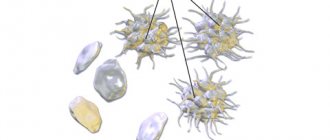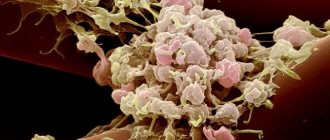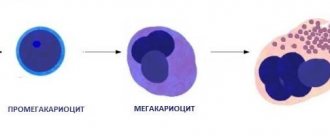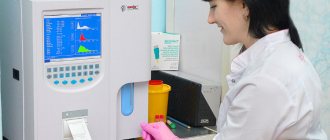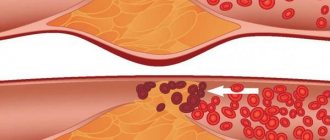P-LCR is a laboratory criterion that reflects the proportion of giant platelet cells in the blood, measured in %, and is normally 13-43%
, regardless of the age and gender of the patient. To determine the index, a special clinical blood test is performed. With this you can find out the number of platelets that regulate blood clotting, their maturity, size and functional activity. Other equally widespread indices are mean platelet volume (MPV) and relative platelet volume distribution width (PDW).
a – normal platelets (against the background of erythrocytes) b – platelets of different volumes (anisocytosis) c – huge macroplatelets (P-LCR increased)
Deviation of P-LCR from the norm is associated with the presence of pathology in the body. The main function of platelets is thrombus formation: the cells form a blood clot, which closes damage to the vascular wall and prevents massive blood loss. When their amount in the blood decreases, the risk of bleeding increases. With a high concentration of platelets, there is a tendency to thrombosis and their severe consequences.
After receiving the results of a general blood test and if the patient has characteristic complaints, specialists conduct a detailed study aimed at determining P-LCR. This diagnostic test is ordered when it is necessary to carefully examine the morphology of platelet cells and count the number of excessively large elements.
Laboratory doctors who performed an extensive blood test evaluate the results and make an appropriate conclusion, on the basis of which clinicians make a final diagnosis. Deviations are usually observed in individuals with recurrent somatic diseases or hereditary anomalies.
examples of diagrams of platelet content in the blood - 1) normal, 2) with a decrease in the total number of platelets and P-LCR, including, 3) with an increase in % P-LCR - the presence of a large number of giant platelets
To determine the large platelet ratio, it is necessary to donate venous blood for analysis. The biomaterial is collected directly in the laboratory. The study is performed immediately. The sooner it is started, the more accurately many indices will be determined. It is necessary to prepare for the analysis: the day before you cannot smoke, drink alcohol, drink coffee and tea, or take medications. Nicotine, ethanol, caffeine and drug components often distort the results. Immediately before donating blood, it is forbidden to eat or drink. A day later, the patient receives a form indicating the result of the study, as well as reference values. The specialist interpreting the analysis must take into account all factors affecting the body and changing the number of large platelets. A P-LCR value in the range of 13-43% is considered normal. If a deviation is detected, an additional examination of the patient is carried out to identify the cause of the problem.
What is P-LCR or large platelet ratio in a blood test and why is the content higher than normal?
Patients are interested in P-lcr in a blood test - what it is, why it is tested.
Decoding this analysis allows you to obtain information about platelets that regulate clotting. For testing, blood can be taken from a finger or from a vein in the case of an advanced analysis. Blood sampling is almost painless and rarely causes discomfort. When taking blood from a vein, the arm is tied with a flagellum, the skin is treated with a disinfectant solution and pricked with a sterile needle. When taking blood from a finger, it is disinfected with an antiseptic and pierced with a medical blade.
The material is collected in a test tube and transferred for research, which must be carried out immediately in the first hours, because then a precipitate may form and it will be difficult to determine many indices.
For the study to be accurate, you need to prepare for it. You should not eat food 8 hours before the test, so the procedure is scheduled in the morning. Blood is taken from the patient on an empty stomach.
On the eve of the analysis you cannot:
- smoke;
- drink alcohol;
- drink coffee or tea;
- take medications.
Some drugs may distort the results. If the patient has chronic diseases that require constant use of medications, it is necessary to inform the doctor about this. The doctor will explain which medications should not be taken before the procedure.
Increase P-LCR
An increased number of large platelets means that there is a pathology in the body. Only in isolated cases is a high P-LCR value an individual characteristic of a person and does not require treatment.
Etiology
The reasons for an increase in P-LCR can be completely different diseases - inflammatory, oncological, hematological, infectious.
But most often, the formation of a large number of large platelets occurs in autoimmune disorders. Systemic diseases that can cause thrombocytosis include: collagenosis (scleroderma, systemic lupus erythematosus, rheumatic diseases, periarteritis nodosa), sarcoidosis, polyarthritis, ankylosing spondylitis, enteropathy. These processes are accompanied by the release of interleukin and other inflammatory mediators into the blood, which stimulate the biosynthesis of thrombopoietin and the formation of a large number of platelets.
Along with this, the P-LCR index increases if the patient has:
- infectious pathology - bacterial, viral, fungal, parasitic,
- post-traumatic and postoperative syndrome,
- oncological and hematological diseases - lymphoma, neuroblastoma and hepatoblastoma, anemia,
- spleen diseases,
- cirrhosis or polycystic liver disease,
- damage or inflammation of the spinal cord,
- alcoholism,
- intoxication with chemicals that disrupt bone marrow function,
- atherosclerosis,
- diabetes mellitus
Some scientists believe that the increase in P-LCR is due to a congenital stem cell defect. In patients, the process of platelet formation is disrupted. The large cellular elements produced are defective and inactive. They are unable to adequately interact with other structures and function fully.
A high P-LCR index leads to the fact that the patient has a tendency to thrombosis. Due to the adhesive properties of platelets, they stick together and form a blood clot, which disrupts blood circulation and prevents the free movement of blood. As the thrombus grows, it narrows the lumen of the vessel, disrupts the blood supply to the organ, and causes hypoxia and ischemia of the tissue. When the coronary arteries are damaged, this leads to myocardial infarction. With thrombosis of cerebral vessels, an ischemic stroke develops. The result of the process is often varicose veins or atherosclerotic changes in the arteries. These pathologies are deadly and often result in the death of patients.
Symptoms
When the P-LCR increases, the patient develops corresponding clinical signs. They may go unnoticed behind the obvious symptoms of the causative disease. Such patients are not treated for thrombocytosis, which further aggravates the situation.
An increase in P-LCR is manifested by the following symptoms:
- hypersensitivity and pain in the fingertips,
- causeless appearance of hematomas,
- irritation and itching of the skin,
- cyanosis,
- asthenia of the body,
- rapid heartbeat,
- shortness of breath at rest,
- visual dysfunction.
These signs are optional. They can appear individually or in various combinations. But despite this, the patient needs to visit a health care facility and undergo certain tests, based on the results of which doctors will determine the cause of the P-LCR deviation and prescribe appropriate treatment.
Treatment and diagnostic procedures
To determine the cause of the disorder and make a correct diagnosis, in serious cases, a bone marrow biopsy is examined and blood is taken again. Additionally, general clinical and molecular tests and ultrasound of internal organs are performed.
To normalize the P-LCR value, the causative disease . If the pathology is not treated, the patient risks dying from thrombosis, or more precisely from its consequences - acute coronary or cerebral failure. These phenomena are very dangerous. They are often fatal. That is why this deviation needs to be corrected. Hematologists carry out diagnostic and treatment measures. Restoration of normal P-LCR levels in a blood test is a sign of adequate and effective therapy.
- Patients are prescribed a diet rich in vegetables and fruits, vegetable oils, freshly squeezed juices and other products that make the blood less viscous. For the same purpose, experts recommend optimizing your drinking regime - drinking up to 2-3 liters of water per day.
- To prevent thrombosis and its consequences, the use of antiplatelet agents and anticoagulants is indicated - Aspirin, Cardiomagnyl, Trental, Cavinton, as well as drugs that improve microcirculation - Dipyridamole, Piracetam, Vinpocetine.
- If the cause of a high level of large platelets is an infectious disease, then after intensive antibiotic therapy, the P-LCR index value returns to normal almost immediately.
- In severe cases, the use of corticosteroids - Prednisolone, Dexamethasone and cytostatics - Anagrelide, Hydroxyurea, Radioactive phosphorus 32P is indicated.
- To stimulate the immune system, Interferon and its derivatives are prescribed.
- There are folk remedies that allow you to correct (but not eliminate) existing violations. These include: mulberry poison, sweet clover infusion, ginger tea, celery juice. These plants have a beneficial effect on the condition and activity of platelets.
Norm
The normal platelet count in the blood of an adult is 13-43%. The indicator may deviate from the norm in some diseases.
Standard values depend on the person’s age:
- The norm for women and men is 180-320x10 9/l.
- In newborns and infants from 180 to 490 × 10 9/l.
- In children under 1 year of age, the indicator is 180-400 × 10 9/l.
- In children from 1 year to 6 years, 160-390 × 10 9/l.
- In children from 7 to 12 years old, 160-380×10 9/l.
- In adolescents from 12 to 18 years old, the indicator is 160-360 × 10 9/l.
If a laboratory test reveals a deviation from the norm, the doctor will prescribe an additional examination in order to establish a diagnosis, because changes in the indicator indicate the presence of pathology.
Different laboratories use different reagents and instruments, so the same person in different laboratories may get different results. The form indicates the patient’s indicators and normal values.
Normal platelet count
The normal platelet level is two hundred to four hundred thousand units/μl. Depending on the age of the person, their number may vary. Thus, for example, in newborns the norm is two hundred eight to four hundred ten thousand units/μl. In the future, as the child grows and develops, their normal number may differ. Therefore, in order to adequately interpret a child’s blood test, you should use special tables of blood indicators according to the baby’s age. What is the norm of platelets - it was said above. A change in the number of blood platelets increases the risk of blood clots or bleeding. If there are abnormalities in the blood test, the test should be taken several times a year as directed by a doctor.
In laboratories, several methods are used to count platelet counts:
- in a special counting chamber with a phase contrast device,
- in painted smears,
- using special hematology analyzers.
Then the obtained indicators are entered into a special form.
Treatment
Minor deviations from the norm do not threaten the patient’s life. The safest and most gentle treatment in this case is diet. It is recommended to include more foods that can thin the blood in your diet. Fresh garlic and onions are especially useful. Tomatoes and fresh juice from them, salad dressings with apple cider vinegar, fish oil, and olive oil reduce platelets. It is also necessary to include foods rich in magnesium in your diet and drink enough liquid, at least 2 liters per day. Avoid products that thicken the blood.
Increased value
An increased value of the large platelet ratio means that pathological processes are present in the patient’s body.
Causes
High levels mean that the following diseases may develop:
- thrombocytosis;
- circulatory disorders;
- obstructed blood movement through the vessels.
When a person is injured, large platelets stick together and form a blood clot, which clogs the damaged vessel and prevents bleeding. If a person’s index increases, then there is a risk of a blood clot in the vessel.
Reduced level
The reasons for a decrease in the P-lcr index can be chronic kidney disease, leukemia, and malaria. The index decreases after heavy metal poisoning and after chemotherapy.
A reduced level of the indicator occurs in pregnant women, after heart surgery, with adverse reactions caused by medications, with alcohol abuse, and lack of vitamin B12 and folic acid.
Thrombocytopenia can be caused by congenital bone marrow diseases and hereditary predisposition to this disease. A decrease in the rate is called thrombocytopenia. This diagnosis is made if the number of platelets has decreased by 3 times.
- the appearance of blood in the urine;
- skin rashes;
- it is difficult to stop bleeding from the nose;
- gums bleed;
- bleeding increases during menstruation.
The cause of thrombocytopenia must be quickly eliminated, because in this case, a minor injury can cause large blood loss. The attending physician must select individual therapy for this condition for the patient.
Lower P-LCR
On the contrary, a decrease in the P-LCR index, as well as the total number of platelets, is a sign of thrombocytopenia. This term unites a whole group of hemorrhagic diathesis, differing in etiology, pathogenesis, and course. As a result of a decrease in the number of platelets in the blood, the risk of bleeding and hemorrhage increases.
Etiology
The giant platelet ratio decreases under the influence of pathological and physiological reasons.
- In healthy people, a reduced content of large platelets in the blood is caused by pregnancy, alcohol abuse, deficiency of B vitamins, and taking certain medications - sedatives, antibacterials, sulfonamides.
- A low level of P-LCR is a laboratory diagnostic criterion for the following diseases: renal pathology, leukemia, malaria, lymphomas, hemangiomas, portal hypertension, tuberculosis infection, influenza, measles, rubella, congenital bone marrow anomalies.
- This indicator decreases as a result of poisoning with heavy metal salts or after cytostatic chemotherapy or radiation therapy.
- Thrombocytopenic purpura is an autoimmune disease in which the body produces antibodies to its own platelets. As a result of their destruction, huge platelet cells are formed with impaired functional activity, which leads to undesirable consequences.
- Hereditary diseases based on giant platelet syndrome. Defective cells are the cause of immune and hematological disorders, occurring in the form of thrombocytopenia with a high tendency to bleeding.
signs of thrombocytopenia/coagulopathy
Symptoms
Clinical signs of low large platelet counts include:
- rapid injury to mucous membranes,
- hematuria,
- blood in stool
- hemorrhagic rash on the skin, petechiae,
- spontaneous and persistent nasal, gingival, uterine, pulmonary, renal, intestinal bleeding,
- heavy and prolonged menstruation,
- ecchymosis at injection sites.
To diagnose a disease that causes thrombocytopenia, patients need to undergo a number of studies:
- coagulogram,
- immunogram,
- MRI and ultrasound of internal organs,
- medical and genetic counseling.
When microscopying a patient's blood sample, platelets of unnaturally large sizes are detected. Specialists record the time during which bleeding occurs, determine the platelet aggregation index, and conduct flow cytometry. The results of a comprehensive diagnostic examination allow doctors to understand the exact picture of the pathology.
Treatment
Thrombocytopenia is dangerous due to the development of spontaneous bleeding, which causes large blood loss. To restore the P-LCR indicator, drug treatment is carried out. Patients are prescribed hemostatic drugs that prevent or stop bleeding - angioprotectors "Etamzilat", "Ditsinon", "Vikasol", fibrinolysis inhibitors "Aminocaproic acid", "Tranexamic acid". They are strictly prohibited from taking drugs with antiplatelet effects - anticoagulants, antiplatelet agents, NSAIDs. These medications interfere with blood clotting and may increase bleeding.
To raise the platelet count to normal, you should eat right, eliminating spicy, salty, fried foods, marinades, and alcohol from your diet.
In severe cases, patients are transfused with platelet mass or donor blood.
All patients with signs of hemorrhagic syndrome are hospitalized in a hospital for emergency medical care. After establishing the cause of the decrease in the number of giant platelets, etiotropic therapy is carried out aimed at eliminating the underlying disease. Patients are prescribed drugs of various groups - glucocorticosteroids, cytostatics, immunomodulators. If conservative treatment fails, removal of the spleen is indicated. Most hereditary pathologies accompanied by a decrease in P-LCR are incurable, lifelong disorders with a high risk of prolonged bleeding, chronic neuropsychiatric problems and death due to major blood loss.
Persons with an increased or decreased P-LCR value need to lead a healthy lifestyle: do not drink or smoke, minimize stress, optimize work and rest schedules, get enough sleep, walk a lot and for a long time in the fresh air, be physically active, but avoid active sports, which may cause injury.
Deviation of P-LCR from the norm is a reason to contact a hematologist and treat existing pathological processes. Don't delay going to the hospital. Self-medication is strictly prohibited. An incorrectly identified cause of the problem can lead to incorrect treatment and the development of serious consequences - thrombosis or hemorrhage.
Symptoms of diseases
The large platelet ratio is a test that must be performed to determine the condition of the blood. Deviations from normal indicators can indicate various diseases. In this case, the level can either increase or decrease depending on the reason. A change in the level of cells in the blood indicates the presence of pathological changes in the human body. To understand what p lcr or large platelet ratio is responsible for and how to bring it back to normal, you need to learn more about these blood cells.
Parameters for research
A medical examination begins with general tests. If there are alarming symptoms and complaints from the patient, the standard test is expanded. In addition to the total number of cells, the laboratory can evaluate their condition, size, mobility, maturity and other factors. So, with a normal overall level of platelets, the number of large cells may be increased, which means a violation of some processes in the body.
The study is carried out in laboratory conditions. The general clinical analysis may not include a P-LCR (Large Platelet Ratio) test. This and other parameters for analysis are indicated in the referral at the discretion of the physician. P-LCR reflects the proportion of enlarged platelets relative to normal-sized cells, measured as a percentage. LCC or large platelet fraction is essentially the same as P-LCR but is measured in absolute value.
During illness or the development of pathology, any of these indicators may be lowered or increased. Changes in the quantity and quality of blood cells, as well as their functions, are reflected by a clinical blood test. To determine possible violations, the test results are deciphered. The interpretation of the obtained data is carried out by a qualified specialist, taking into account all factors that could influence the results of the study.
What are platelets
Red blood cells produced in the bone marrow are called platelets. They lack a nucleus and are the smallest cells compared to white blood cells and red blood cells. Despite this, their importance in the body is very great.
Thanks to these cells, blood has the ability to clot, which protects a person from blood loss during wounds and injuries:
- An abnormal platelet level often indicates diseases that occur in the human body.
- But the number of cells can also change due to temporary factors, for example, after physical activity.
After production, platelets remain in the blood for 5 to 11 days, after which they are destroyed in organs such as the liver and kidneys.
Based on their origin, platelets are divided into 3 types:
The division into types occurs depending on the reason that caused the generation of cells. Several factors can influence an increase or decrease in the large platelet ratio.
A blood test and further examination of the person will help identify the underlying cause. After which the doctor prescribes treatment adequate to the disease, and the patient may be hospitalized: the sooner the causes are identified, the more effective and easier the course leading to recovery will be.
Decreased platelet count
This condition is called thrombocytopenia ( platelet count 100 ) and often develops after uncontrolled medication use. Leukocytopenia can accompany pathologies such as cirrhosis, hepatitis, bone marrow damage, thyroid diseases, hematological diseases, alcoholism and other pathologies. As a result of these diseases, the fragility of blood vessels increases. Long periods of menstruation, cuts, tooth extraction, bleeding gums, and frequent nosebleeds can also contribute to low platelet counts.
Thrombocytosis rate table
First of all, medications are used to treat a low platelet count. If necessary, doctors prescribe platelet transfusions.
Symptoms
When the P-LCR is elevated, the patient exhibits physical symptoms of the condition. In most cases, they can be overlooked due to obvious symptoms of the underlying disease. When treating a disease in a hospital setting under the supervision of the attending physician, blood is taken regularly for testing. At the same time, it is impossible to miss the moment when the level of platelets or P-LCR begins to increase. But the patient himself can determine the condition in which platelet cells increase in size by the following symptoms.
- High sensitivity of the fingers, especially the tips, to the point of pain.
- The appearance of bruises and subcutaneous hemorrhages for no apparent reason.
- A bluish tint to the skin and an itchy sensation.
- General weakness of the body, lethargy, decreased ability to work.
- Decreased vision.
- Frequent nose and intestinal bleeding, women have heavy periods.
It is extremely unlikely that all symptoms of high P-LCR will occur at once. As a rule, patients note the appearance of 2-3 signs, which is a reason to consult a doctor and undergo appropriate tests. The sooner the cause of the disease is identified, the higher the chances of a speedy and successful recovery.
Reasons for changing the coefficient
As already mentioned, various factors can cause a decrease or increase in the level of large platelets.
- inflammatory processes;
- various diseases;
- hematological factors;
- temporary reasons.
Inflammatory processes that provoke a sharp increase in red blood cells in the blood include diseases such as hepatitis, polyarthritis, rheumatoid purpura, inflammatory enteropathy and others. Having a negative effect on the body, these diseases provoke an increase in interleukins, which are an anti-inflammatory substance. The production of these substances is accompanied by an increase in platelet counts in the blood.
And cancer cells can also provoke a change in the coefficient. Oncological diseases often cause thrombocytosis. Lymphomas and hepatoblastoma can also lead to changes. And also the level of cells in the blood changes in patients during the postoperative period. People who are anemic usually have elevated platelet levels in their blood tests.
Reasons that may temporarily affect platelets may include:
- pregnancy;
- injuries;
- physical exercise;
- suffered stress.
The reasons for the change may be temporary (in which case the condition returns to normal without much effort) or such that they will require long-term treatment.
Causes and symptoms of increased platelet levels
Platelets are the smallest blood cells that perform important functions
There are quite a few reasons why a patient is diagnosed with platelets higher than normal. Thrombocytosis can develop as a result of bleeding - external or internal. The body reacts to blood loss by increasing the production of platelets so that they can close the tissue or vascular defect and stop blood loss. This is a kind of protective reaction of the body caused by a direct threat to it.
The level of platelets in the blood also increases during stress, severe anxiety, or during a scandal. It increases when the functions of bone marrow cells are impaired, during injuries and during surgical operations, that is, whenever there is a risk of blood loss.
- Thrombocrit is increased in the blood of an adult and a child. What does this mean, treatment
Excess weight, obesity, and alcohol abuse contribute to an increase in the number of platelets. But the most dangerous reasons for an increase in such indicators are serious illnesses:
- Tuberculosis.
- Leukemia.
- Lymphogranulomatosis.
- Oncological lesions of the kidneys or liver.
An increase in the level of red blood cells also accompanies such conditions and diseases as the following:
- Erythrocytosis.
- Chronic myeloid leukemia.
- Hemolysis.
- Anemia.
- Enteritis.
- Arthritis.
- Intoxication.
Any significant change in platelet levels, down or up, indicates problems in the body and can threaten health and even life. Therefore, when such deviations are detected, it is necessary to carry out an accurate diagnosis to identify the exact cause of the violation.
Thrombocytosis does not mean any increase in platelet levels, but only those that remain at high levels for a long time.
Slight fluctuations in the number of these cells in the blood can be caused by physiological reasons, such as thirst or drinking alcohol. Also, the platelet level fluctuates naturally throughout the day, but these surges cannot be considered significant disturbances, since they are normal physiological manifestations.
The following symptoms may be considered signs of thrombocytosis:
- Headache, cramps, dizziness.
- The person suffers from weakness, which can sometimes be very pronounced.
- The patient may experience various vision problems.
- Particles and streaks of blood may be found in the stool.
- Nosebleeds.
- Increased bleeding of gums.
If such signs appear, you must seek help from a hematologist and undergo a full comprehensive examination.
Danger signs and complications
A high platelet count may be a sign of a dangerous pathology
If platelets are kept at high levels above normal, this may indicate the presence of very dangerous diseases. They are manifested by cyanosis, a tendency to bleeding and the appearance of bruises and hemorrhages even with a light touch, skin itching, shortness of breath, and vegetative-vascular dystonia.
- How to increase platelets in the blood?
With a high level of platelets, the patient is at risk of thrombosis, that is, the formation of large dense blood clots that clog the lumen of the vessel.
Such conditions threaten the development of some deadly diseases:
- Pulmonary embolism.
- Strokes.
- Heart attacks and many others.
Each of these diseases poses a huge threat to the health and life of the patient. Vascular thrombosis of the extremities can cause the development of gangrene, and this is a direct path to amputation. Strokes and heart attacks are leading causes of death, especially in people aged 50 years and older.
